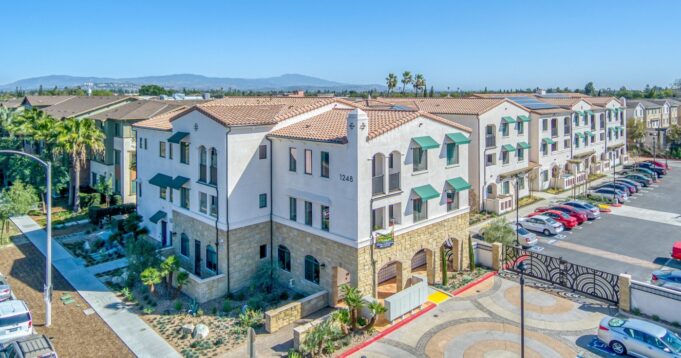Any community that has considered where to build affordable housing has probably heard some version of these concerns: “If you put this in my community, crime is going to go up and my housing value is going to go down.” That’s the perception UC Irvine professor George Tita, who heads the university’s Livable Cities Lab, often hears – and a new study he and his colleagues just completed looks at affordable developments in Orange County to explore whether those assumptions are supported by facts.
The researchers will share key findings of the study Thursday in an event at Irvine City Hall. While there are nuances to the data, Tita said it lines up with other studies that show affordable housing doesn’t drag down the quality of a community.
“Affordable housing at the very worst has no impact on crime or housing values,” Tita said.
And, in many cases, he said, “there is a positive impact on the price of homes sold and the average price per square foot of homes sold in the three years after affordable housing is placed” in a neighborhood.
Researchers are still analyzing the data, but those are the top-line conclusions.
There could be several factors driving those results: high standards in regulations require affordable developments to look as nice or nicer than other housing in the community, and, as Tita pointed out, a quality new build is an investment in the neighborhood that might be replacing a disused lot or a run-down motel that saw frequent police calls.
Whatever is at the root of the findings, they’re not a surprise to Lucy Dunn, the former head of the Orange County Business Council. She said she’s been hearing arguments about home values and crime since she headed the state Housing and Community Development Department under Gov. Arnold Schawzenegger.
They stem from “fear of change and fear of newcomers,” Dunn said, but in the early 2000s there weren’t any studies to help put those fears to rest.
Now the issue has been looked at by a number of researchers (Tita said they’ve largely drawn conclusions that match his findings), but the UCI study is the first to specifically look at Orange County.
Tita said people are less likely to be persuaded by data from a different community in another state, and he hopes local policy makers can use the UCI study “to influence some skeptics on the issue.”
No negative impacts
The study was funded by several affordable housing developers, two nonprofits, the Orange County Housing Authority and the cities of Anaheim and Garden Grove. It focused on a list of 371 developments around the county that are designated as “affordable,” which usually means tenants have to meet income guidelines or other criteria, and their rent is restricted or subsidized. Emergency shelters were not included.
While Irvine has the most affordable homes of any OC city, the study shows affordable developments are scattered around the county – but more heavily concentrated in the northern cities.
Residents start to move into Sage Park, Irvine’s new affordable housing complex in January 2022. (File photo by Mindy Schauer, Orange County Register/SCNG) Residents start to move into Sage Park, Irvine’s new affordable housing complex this week. The grand opening ceremony on Wednesday, January 26, 2022 celebrated the completion of 32 of the 68 two-to three-story townhomes built. (Photo by Mindy Schauer, Orange County Register/SCNG)
Economic and demographic data show much of the county’s affordable housing is in communities that are less White and have lower median incomes and home values, Tita said.
Using 20 years of sales data for homes within two miles of an affordable development (and adjusting to account for the 2008 recession and more recent home price explosion), researchers looked at what happened to values before and after an affordable development opened.
In lower-income communities, homes closest to an affordable site typically increased in value after the new housing was built, according to the study. In higher-income communities, the nearest homes sometimes saw their overall value decrease slightly after the addition of affordable housing, but the study said those tended to be larger homes. Generally the price per square foot actually went up, just as it did in poorer neighborhoods.
Orange County already has a lower crime rate than the state overall, Tita noted, and putting in affordable housing appears to either reduce violent crimes such as robbery and aggravated assault or have no impact.
Property crimes in some cases increased very slightly – say, one additional car break-in every two years within a fifth of a mile of the new housing – but Tita called the overall impact of that “imperceptible.”
Irvine, which is consistently deemed one of the safest places to live, has been successful in its addition of affordable housing in part because, as a newer city, it’s been able to incorporate lower-income homes as new developments are built – and that means often there aren’t existing neighbors to object, said Councilman Anthony Kuo, who grew up in the city.
To meet city requirements, many market-rate developments include a small percentage of affordable units and the developments use the same quality of materials as any other housing, he said.
“That makes people part of the community,” Kuo said. “No one’s going to say, ‘Oh well, that apartment building on the corner in the back is the poor people,’ because we’ve deliberately incorporated those apartment communities into the greater community.”
Steve Rosansky was on the Newport Beach City Council in 2015 when it approved over the objections of some in the neighborhood a 12-unit complex in Newport Shores for rent to veterans and seniors with lower incomes. There’s been “no impact at all, from what I can tell, except some seniors have a very nice place to live,” he said.
One less barrier?
Michael Manville, associate professor of urban planning at UCLA’s Luskin School of Public Affairs, said the findings of the UCI study aren’t surprising for a few reasons.
Part of the lack of impact is due to “very strict quality controls” on affordable housing, he said, adding that not only is it highly regulated, “we put it in places where lower-income people are already likely to live.”
There’s some evidence that the addition of affordable housing can bring down property values in affluent, exclusive areas, Manville said, but not much – because it’s so rarely allowed.
But, he added, “the purpose of public policy is not to keep your home value high.”
Tita said the Orange County data is adding to existing studies that also have found that affordable housing is more likely to help boost the prices of nearby homes than the reverse.
“We hope that this study will eliminate one barrier to building more affordable housing in Orange County,” he said. “We know that many others exist.”
UCI Livable Cities Lab researchers will present their study findings at 3:30 p.m. Thursday in the City Council Chamber at Irvine City Hall, 1 Civic Center Plaza, Irvine. People are asked to RSVP here to attend.











